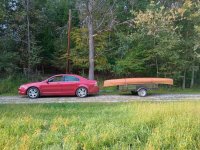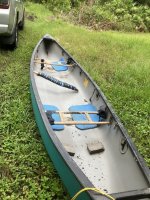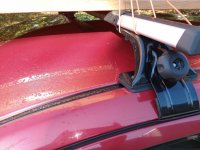Just to update: I decided against drilling holes in the roof and bought a pair of clamp-on roof racks. All contact points had rubber pads so the paint was safe and they seemed to tighten up well on the door openings. When installed on front & rear doors, however, they would have been about 4-5 feet apart and I didn't care for that with 16 foot(ish) canoes.
My solution: I bought & installed a class 1 receiver, had a buddy weld up a t-post for it and, using the front clamp-on with the t-post at the rear bumper, the set-up gives me support with more comfortable spacing.
A couple of webbing loops attached to body bolts in the trunk help stabilize the t-post
View attachment 149305
and I put a piece of used bike inner tube on both the clamp-on rack and the t-post and then wrapped black Gorilla Tape over the bars. (the inner tube is there to protect the gunwales when the canoe rubs through the Gorilla Tape. (I assume that it will eventually)
View attachment 149306
The t-post is bolted together rather than welded as my buddy thought it would go in the trunk more easily while I'm out paddling. Really nice design IMO.
Here's the final assembly in action.
View attachment 149307
In case anyone's wondering, yes, the rear is squatting a little because the trunk is full of horse shoes, anvil, etc. Until I can find a "can't pass this up" deal on a truck, this little car will have to do it all.







